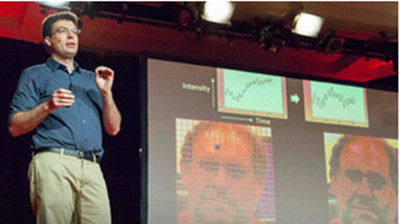(单词翻译:单击)
视频文本
So here's the sound that we played in the room.
这是我们在房间中播放的声音。
And this is a high-speed video we recorded of that bag of chips.
这是我们摄制的薯片袋的高速视频。
Again it's playing.
同样,
There's no chance you'll be able to see anything going on in that video just by looking at it,but here's the sound we were able to recover just by analyzing the tiny motions in that video.
您凭肉眼是看不出来什么的,但是我们可以通过分析视频中微小的振动恢复出原有的声音。
I call it Thank you.
我叫它-谢谢。

I call it the visual microphone.
我叫它视觉麦克风。
We actually extract audio signals from video signals.
实际上我们从视频信号中提取了音频信号。
And just to give you a sense of the scale of the motions here,a pretty loud sound will cause that bag of chips to move less than a micrometer.
为了让您了解运动的大小,一个特别大的声音可以导致薯片袋一微米的变化。
That's one thousandth of a millimeter.
也就是千分之一毫米。
That's how tiny the motions are that we are now able to pull out just by observing how light bounces off objects and gets recorded by our cameras.
这就是我们能够提取出来的微小运动仅仅是通过摄像机录制的视频观察光线在物体上的变化。
We can recover sounds from other objects, like plants.
我们可以从物体上重构出原声音,如植物。
And we can recover speech as well.
我们也可以重构出讲话。
So here's a person speaking in a room.
这是一个人在房间中讲话。
Michael Rubinstein: And here's that speech again recovered just from this video of that same bag of chips.
迈克尔鲁宾斯坦:这是一个讲话这段视频同样是由那个薯片袋重构出声音。
We used Mary Had a Little Lamb because those are said to be the first words,that Thomas Edison spoke into his phonograph in 1877.
我们用儿歌Mary Had a Little Lamb因为托马斯爱迪生在1877年,第一次录制在留声机上的也是这首儿歌。
It was one of the first sound recording devices in history.
这是历史上第一个录音设备。
It basically directed the sounds onto a diaphragm that vibrated a needle that essentially engraved the sound on tinfoil.
原理是把声音录在薄膜上声音通过振动的针头刻录在锡箔上,
that was wrapped around the cylinder.
锡箔被包裹在圆柱体上。
Here's a demonstration of recording and replaying sound with Edison's phonograph.
这是演示爱迪生留声机的录制和回放。
And now, 137 years later,we're able to get sound in pretty much similar quality but by just watching objects vibrate to sound with cameras,and we can even do that when the camera is 15 feet away from the object, behind soundproof glass.
137年过去了,我们可以重构出同样质量的声音却是通过观察摄像机拍摄的物体振动实现的,我们甚至可以把摄像机放到15英尺外隔音玻璃后边。
So this is the sound that we were able to recover in that case.
这是我们在这种情况下还原的声音。
And of course, surveillance is the first application that comes to mind.
当然,监控是我们想到的第一个应用。
But it might actually be useful for other things as well.
但是它应该还有其他用处。
Maybe in the future, we'll be able to use it, for example,to recover sound across space,because sound can't travel in space, but light can.
可能,未来我们可以用它太空中还原声音,因为声音不可以在太空中传播,但光可以。
We've only just begun exploring other possible uses for this new technology.
我们仅仅是刚刚开始探索这项新技术的可能用途。
It lets us see physical processes that we know are there,but that we've never been able to see with our own eyes until now.
这让我们熟知的物理过程,变得肉眼可见了。
This is our team.
这是我们的团队。
Everything I showed you today is a result of a collaboration with this great group of people you see here,and I encourage you and welcome you to check out our website,try it out yourself,and join us in exploring this world of tiny motions.
今天我展示的一切,都是这群伟大的人的协作成果。我鼓励您,欢迎您访问我们的网站,亲身体验,加入我们,一同探索微小振动的世界。
Thank you.
谢谢。
视频及简介
视频简介:
看看“运动显微镜”,一个视频处理软件,可以把运动或颜色的微小变化转化为肉眼可见。视频研究员迈克尔·鲁宾斯坦播放了一段令人惊异的视频,视频中展示了这项技术可以从一段视频获取某人的脉搏和心跳。看他通过放大声音在薯片袋上造成的震动,重构出声音。这项技术令人叹为观止的邪恶应用,您有必要眼见为实。


